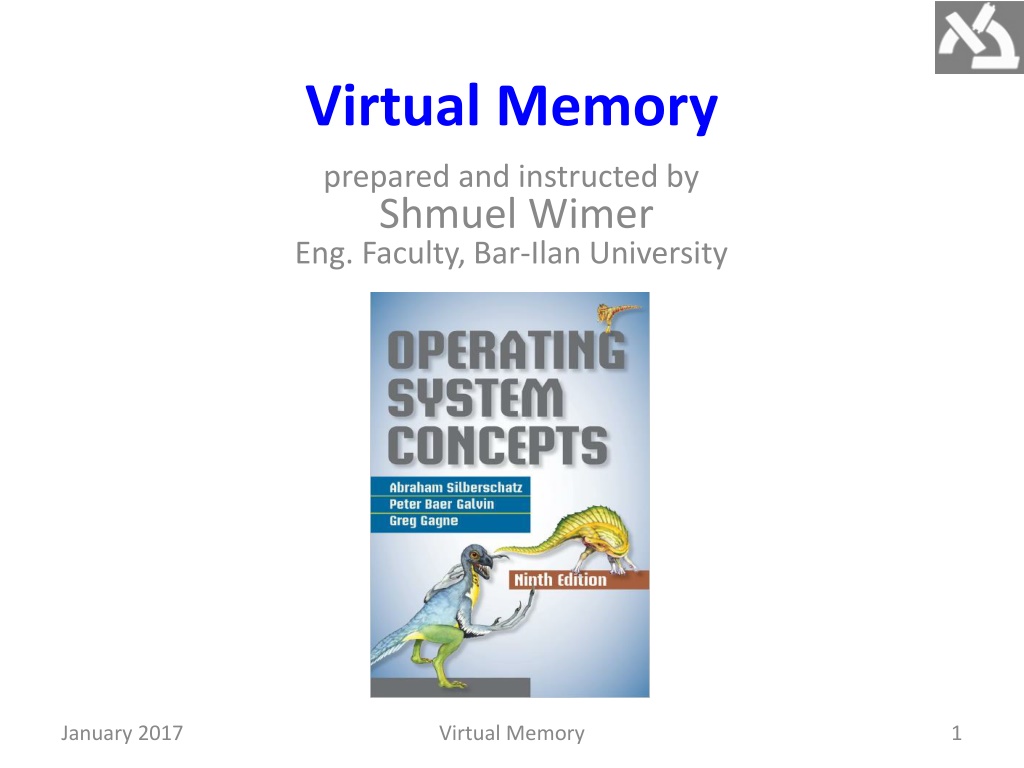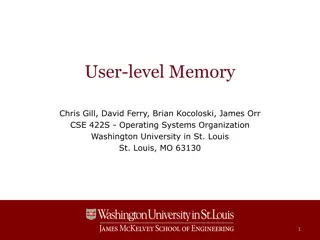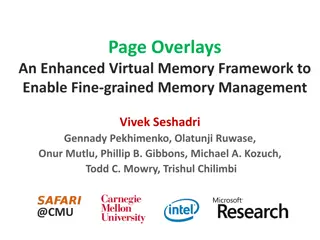Understanding Virtual Memory Concepts and Benefits
Virtual Memory, instructed by Shmuel Wimer, separates logical memory from physical memory, enabling efficient utilization of memory resources. By using virtual memory, programs can run partially in memory, reducing constraints imposed by physical memory limitations. This also enhances CPU utilization, speeds up program execution, and allows for sharing of memory resources among processes. Virtual address spaces with holes can be dynamically filled to accommodate growing stack or heap requirements. Overall, virtual memory offers numerous advantages in managing memory resources effectively.
Download Presentation

Please find below an Image/Link to download the presentation.
The content on the website is provided AS IS for your information and personal use only. It may not be sold, licensed, or shared on other websites without obtaining consent from the author. Download presentation by click this link. If you encounter any issues during the download, it is possible that the publisher has removed the file from their server.
E N D
Presentation Transcript
Virtual Memory prepared and instructed by Shmuel Wimer Eng. Faculty, Bar-Ilan University January 2017 Virtual Memory 1
Virtual Memory (VM) Concept So far the entire logical address space was placed in physical memory. Requiring executed instructions be in physical memory is necessary and reasonable. It is also unfortunate, since it limits the size of a program to the size of physical memory. In many cases, the entire program is not needed. Code handling unusual error conditions. Arrays, lists, and tables are often allocated more memory than actually needed. January 2017 Virtual Memory 2
Even if the entire program is needed, it may not all be needed at the same time. Executing program only partially in memory would have many benefits: Program no longer constrained by available physical memory, simplifying programming. Programs using less physical memory enable more programs running concurrently, increasing CPU utilization and throughput. Less I/O needed to load or swap user programs into memory, so user program would run faster. January 2017 Virtual Memory 3
page swapping logical addresses main memory hard disk page in memory page table page in disk VM that is larger than physical memory. January 2017 Virtual Memory 4
Virtual Memory (VM) separates the logical memory as perceived by users from the physical memory. The virtual address space of a process is the logical view of how a process is stored in memory. Typically, a process begins at a certain logical address, say 0, and exists in contiguous memory. Physical memory is organized in frames assigned to process, which may not be contiguous (MMU maps logical pages to physical page frames in memory). January 2017 Virtual Memory 5
The large blank space (hole) between the heap and the stack is part of the virtual address space. It will require actual physical pages only if the heap or stack grows. Virtual address space. January 2017 Virtual Memory 6
Virtual address spaces that include holes can be filled as the stack or heap grow or by dynamically link libraries during program execution. VM allows files and memory to be shared by processes through page sharing. System libraries can be shared by processes through mapping of shared object into a virtual address space. Each process considers the libraries as part of its virtual address space, but their frames in physical memory are shared by all processes. January 2017 Virtual Memory 7
logical addresses (virtual, pages) logical addresses (virtual , pages) physical addresses (frames) Shared library using virtual memory. January 2017 Virtual Memory 8
Demand Paging Instead of loading entire program in physical memory, pages are loaded only as needed, called demand paging. Pages never accessed are never loaded. A demand-paging system is similar to a paging system with swapping, where processes reside in disk. When process swapped in, pager guesses which pages will be used, before another process swapped out. The pager brings only those pages into memory, thus decreasing swap time and amount of physical memory. January 2017 Virtual Memory 9
Need HW support to distinguish between pages in memory and the pages on disk. Valid invalid bit is used. Valid means the page is both legal and in memory, Invalid means page is either not in logical address space, or currently on disk. Entry for a page not currently in memory is either marked invalid or contains the disk address of the page. January 2017 Virtual Memory 10
Some pages are not in main memory. January 2017 Virtual Memory 11
Steps in handling a page fault. January 2017 Virtual Memory 12
Attempt to access a page marked invalid causes a page fault. Paging HW notice at translation that invalid bit is set, causing OS trap of failure to bring page into memory. The procedure for handling page fault is 1. Check table (kept with PCB) for this process to determine whether the reference was valid invalid memory access. 2. If invalid, process terminated. If valid but not yet brought in, it is paged in. January 2017 Virtual Memory 13
3. Find a free frame (taking one from the free-frame list). 4. Schedule a disk operation to read the desired page into newly allocated frame. 5. When disk read completes, modify the internal table kept with PCB and the page table to indicate page is now in memory. 6. Restart the instruction that was interrupted by the trap. The process can now access the page. January 2017 Virtual Memory 14
Performance of Demand Paging Memory access time ranges from 10nSec to 200nSec. With no page faults this is the effective access time. Let 0 ? 1 be the probability of a page fault, desired to be close to zero. (0 ? 1). The effective access time is: (1 ?) ma + ? page fault time. A page fault causes the following sequence: 1. Trap to the operating system. 2. Save the user registers and process state. January 2017 Virtual Memory 15
3. Determine that interrupt was a page fault. 4. Check legal page ref and determine disk location. 5. Issue a read from the disk to a free frame: Wait in device queue until read request is serviced. Wait for the device seek and/or latency time. Begin the transfer of the page to a free frame. 6. While waiting, allocate the CPU to some other user. 7. Receive completion interrupt from I/O subsystem. 8. Save registers and process state for the other user. January 2017 Virtual Memory 16
9. Determine that the interrupt was from the disk. 10.Correct tables to show that page is now in memory. 11.Wait for CPU to be allocated to this process again. 12.Restore user registers, process state, and new page table, then resume the interrupted instruction. Three major components of the page-fault service time: 1. Service the page-fault interrupt 1 Sec - 100 Sec. 2. Read in the page ~8mSec. 3. Restart the process 1 Sec - 100 Sec. January 2017 Virtual Memory 17
Page-switch takes 8mSec (latency 3mSec, seek 5mSec, and transfer 0.05mSec.) Device-queueing time is added, increasing time swap. Page-fault may slow process execution dramatically. The effective access time is (1 ?) 200nSec + ? 8,000,000nSec If 1/1,000 causes page fault, effective access time is 8.2?Sec, X40 computer slow down by demand paging! Degradation < 10%, requires less than 1/400,000 faults. January 2017 Virtual Memory 18
Page Replacement Need for page replacement. January 2017 Virtual Memory 19
Page-fault service routine does: 1. Finds location of desired page on the disk. 2. Finds free frame: If there is, it is used. If not, replacement algorithm selects victim frame. Victim written to disk, update page and frame tables. 3. Read desired page into freed frame, update page and frame tables. 4. Continue process from where page fault occurred. If no frames are free, twopage transfers are required. January 2017 Virtual Memory 20
physical frame f occupied this logic page v i logic page caused fault selected for eviction (paged out) page table after update faulted page will occupy frame f (paged in) Page replacement. January 2017 Virtual Memory 21
Usage of a dirty bit can save writing the victim back to disk. Also applies to read-only pages (e.g. binary code). Page programmers on a smaller physical memory. replacement enables enormous VM for Without demand paging, all the pages of a process must be in physical memory. Two major problems: Frame-allocation algorithm. How many frames to allocate to each process? Page-replacement algorithm. When page replacement is required, select the frames to be replaced. January 2017 Virtual Memory 22
Algorithm evaluation is done by applying memory reference strings and computing the page faults. Example. A 100 bytes per page and address sequence: 0100, 0432, 0101, 0612, 0102, 0103, 0104, 0101, 0611, 0102, 0103, 0104, 0101, 0610, 0102, 0103, 0104, 0101, 0609, 0102, 0105 is shortened to the following reference string: 1, 4, 1, 6, 1, 6, 1, 6, 1, 6, 1 Need to know the number of page frames available. Increasing their number decreases page faults. January 2017 Virtual Memory 23
Page faults versus number of frames. January 2017 Virtual Memory 24
FIFO Page Replacement For the reference 7, 0, 1, 2, 0, 3, 0, 4, 2, 3, 0, 3, 2, 1, 2, 0, 1, 7, 0, 1 and 3 frames, FIFO yields FIFO is easy to implement but may suffer of poor performance. January 2017 Virtual Memory 25
To illustrate the problems with FIFO, consider the reference 1, 2, 3, 4, 1, 2, 5, 1, 2, 3, 4, 5 Anomaly: the page-fault rate may increaseas the number of allocated frames increases! January 2017 Virtual Memory 26
Optimal Page Replacement Optimal replacement, called OPT or MIN, has the lowest page-fault rate and does not suffer from anomaly: Replace the page that will not be used for the longest period of time. Unfortunately, MIN requires future knowledge of reference, so it is used mainly for comparison studies. January 2017 Virtual Memory 27
LRU Page Replacement Replace the page that has not been used for the longest period of time, namely, the least recently used (LRU). This is MIN looking backward in time. LRU is popular and considered good, but its HW implementation is expensive. January 2017 Virtual Memory 28
Two SW implementations are possible: Time-stamp associated with each page-table entry, updated at page reference. Page with smallest is replaced. Stack.A referenced page is removed from the stack and put on the top. MRU is at the top and LRU is at the bottom (implementation with doubly linked list). Both implementation require HW assistance, since updated occurs at each memory reference. Using interrupt for every reference to allow SW update would slow memory reference by X10! January 2017 Virtual Memory 29
LRU-Approximation Additional-reference-bits algorithm. Each page table is supplemented with 8-bit shift register. Reference to page sets the MSB. At regular intervals (e.g. 100mSec ), an interrupt transfers control to OS, which shifts the bits right. The shift registers thus contain the history of page use for the last eight time periods. 00000000 means the page has not been used for eight time periods, 11111111 means it was used at each. The page with the lowest number is replaced. January 2017 Virtual Memory 30
We can either swap out all pages with the smallest value or use FIFO method to choose among them. The number of bits of history included in the shift register can vary and is selected to make the updating as fast as possible. In the extreme case, the number can be reduced to zero, leaving only reference bit. Second-chance page-replacement algorithm. Basic FIFO with inspection of reference bit. If 0, replacement takes place, else, page is given a second chance, moving to next FIFO page. January 2017 Virtual Memory 31
Second chance clears the reference bit, and its arrival time is reset to the current time. Page given second chance will not be replaced until all other pages are replaced or given second chances. Page used often enough, will never be replaced. Second-chance uses a circular queue, where pointer indicates the next page to be replaced. The pointer advances until it finds page with 0 reference bit, clearing reference bits along advancements. Once victim is found, it is replaced, and new page is inserted in the circular queue in that position. January 2017 Virtual Memory 32
Second-chance page-replacement algorithm. January 2017 Virtual Memory 33
Enhanced second-chance algorithm uses two bits. Each page is in one of four classes: (0,0) Neither recent use nor modified, best to replace. (0,1) Not recent use but modified, page need written out before replaced. (1,0) Recent use but clean, probably used again soon. (1,1) Recent use and modified, probably used again soon, page need written out before replaced. Same scheme as second-chance, replacing the first page encountered in the lowest nonempty class. January 2017 Virtual Memory 34
Counting-Based Page Replacement Least frequently used (LFU) replaces the page with smallest count. Problem: page used heavily initially but never used again. Due to the large count it remains in memory though not needed. Solved by 1-bit shift right at regular intervals, forming exponentially decaying average usage count. Most frequently used (MFU) assumes that page with smallest count was just brought in, yet to be used. Both uncommon. Expensive, badly approximate OPT. January 2017 Virtual Memory 35
Allocation of Frames How to allocate the fixed amount of free memory among processes? The architecture (ISA) determines the minimum number of frames allocated to process. ISA with memory instructions of direct address requires at least two frames, one for the instruction and one for the memory reference. ISA with indirect addressing require at least three frames, e.g. load instruction on page 16 refers to address on page 0, which is indirectly referring page 23. January 2017 Virtual Memory 36
What happens if a process had only two frames? The maximum number of frames per process is defined by the amount of available physical memory. Equal allocation splits ?frames among ?processes giving everyone ?/?frames. Proportional processes need different amounts of memory, allocating memory to process according to its size. allocation recognizes that various January 2017 Virtual Memory 37
Global and Local Allocation Page-replacement algorithms are classified into: Global: selecting replacement frame from all frames, even if currently allocated to other process. It allows high-priority process increasing its frames on the account of a low-priority process. Local: selecting from process s own allocated frames. Problem with global is that process s pages in memory depend not only on its paging behavior but also on other processes. January 2017 Virtual Memory 38
Thrashing If the number of process s allocated frames falls below the minimum required by ISA, it must be suspended. Its remaining pages are paged out and all its allocated frames are freed, resulting swap in/out intermediate CPU scheduling. Process having not number of frames needed to support pages in active use, will quickly page-fault, replacing needed very soon. This results in extensive paging, called thrashing, where process spending more time paging than executing. January 2017 Virtual Memory 39
A cause of trashing is the OS monitoring CPU utilization, if too low it increases the multiprogramming. Global page-replacement replaces pages regardless of process to which they belong. A process entering new execution phase needs more frames, starting faulting, taking other processes frames. As processes wait for the paging device, CPU utilization decreases, causing CPU multiprogramming degree. scheduler to increase Eventually, no work is done, as processes just paging. January 2017 Virtual Memory 40
Thrashing. January 2017 Virtual Memory 41























